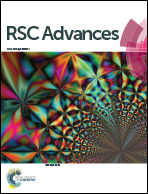Heteroepitaxial TiO2@W-doped VO2 core/shell nanocrystal films: preparation, characterization, and application as bifunctional window coatings
Abstract
In this study, we have employed rutile TiO2 nanoparticles (TiNPs) as cores for coating with vanadium sols of various concentrations and a tungsten doping of 2 at%. We grew the W-doped VO2(M) nanocrystals (WVNCs) heteroepitaxially as shells onto the TiNP cores after a sintering process. Needle-like structures gradually appeared for the WVNCs on the TiNP surfaces upon increasing the concentration of the vanadium sol coating. These needle-like structures decreased the surface contact area sufficiently to result in superhydrophobicity. Falling water droplets rebounded completely from the TiNPs@WVNC films, thereby potentially preventing fouling of such materials. The superhydrophobicity of a TiNPs@WVNC film remained stable after 90 min of UV irradiation. The WVNC shells grew epitaxially on the TiNP seeds and enhanced the visible transmittance and near-infrared switching efficiency due to the needle-like structures; this was similar to the behavior of an anti-reflection coating. In addition, the TiNP cores in the TiNPs@WVNC films completely retained their photocatalytic properties. Such bifunctional (self-cleaning and thermochromic) nanomaterials might have applications in energy-saving smart windows.


 Please wait while we load your content...
Please wait while we load your content...